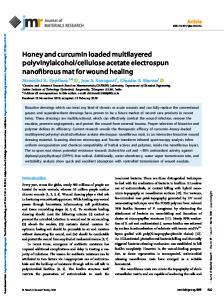Potential of electrospun cellulose acetate nanofiber mat integrated with silver nanoparticles from Azadirachta indica as
- PDF / 3,171,526 Bytes
- 11 Pages / 595.276 x 790.866 pts Page_size
- 107 Downloads / 400 Views
ORIGINAL PAPER
Potential of electrospun cellulose acetate nanofiber mat integrated with silver nanoparticles from Azadirachta indica as antimicrobial agent Pallavi Srivastava1 · G. B. V. S. Lakshmi1 · Smriti Sri1 · Deepika Chauhan1 · Amrita Chakraborty2 · Shailja Singh2 · Pratima R. Solanki1 Received: 19 May 2020 / Accepted: 25 September 2020 © The Polymer Society, Taipei 2020
Abstract The present study aimed to assess the anti-microbial and anti-biofilm properties of an electrospun cellulose acetate nanofiber mat integrated with green synthesized silver nanoparticles (CA-g-AgNP nanomat). Electrospun CA and CA-g-AgNP nanomat were fabricated and the characterization was performed by scanning electron microscopy, transmission electron microscopy, X-ray diffraction, Fourier transformed infrared spectroscopy, and contact angle measurement. Counting of colony-forming units (CFU) and disk diffusion assay were performed to investigate the antimicrobial activity of the CA-g-AgNP nanomat. The anti-biofilm properties of the CA-g-AgNP nanomat were also assessed. Results showed much higher efficacy of the CA-g-AgNP nanomat against gram-positive Staphylococcus aureus, with enhanced internalization of the NPs. The biocompatibility of the CA-g-AgNP nanomat was monitored with MH-S cell lines, macrophage cell lines of Mus musculus. The biofilm formation was significantly inhibited and was found to be reduced by 50% in the presence of the CA-g-AgNP nanomat. Concomitantly, the application of the CA-g-AgNP nanomat resulted in a substantial reduction in CFU/mL. The CA-g-AgNP nanomat, with excellent activity towards biofilms, holds much promise for application in healthcare and the design of antimicrobial nanomat and wound dressing materials. Keywords Cellulose acetate · Green nanoparticles · Bio-films · Nanofiber mats · Antimicrobial activity
Introduction Biofilms are associated with multiple healthcare-related modalities. Biofilm formation by microorganisms has emerged as a significant health threat worldwide, as these biofilms exhibit tolerance to chemical agents, adverse environmental conditions, antimicrobials, and the immune system, thus imposing a significant cost burden [1, 2]. Biofilms can contribute to healthcare-associated infections and even multidrug resistance [3, 4]. They can adhere to both living and synthetic surfaces, and have been implicated in the development of infections related to wounds and implanted * Pratima R. Solanki [email protected]; [email protected] 1
Special Centre for Nanoscience, Jawaharlal Nehru University, New Delhi 110067, India
Special Centre for Molecular Medicine, Jawaharlal Nehru University, New Delhi 110067, India
2
medical devices [5, 6]. Since the very first report of a possible link between biofilms and medical device-associated infection by Johanson et al., a number of microorganisms, including Staphylococcus aureus,gram-positive bacteria, have been isolated from well-organized bio-films that are associated with healthcare-related infections [7–9]. As most tradit
Data Loading...











